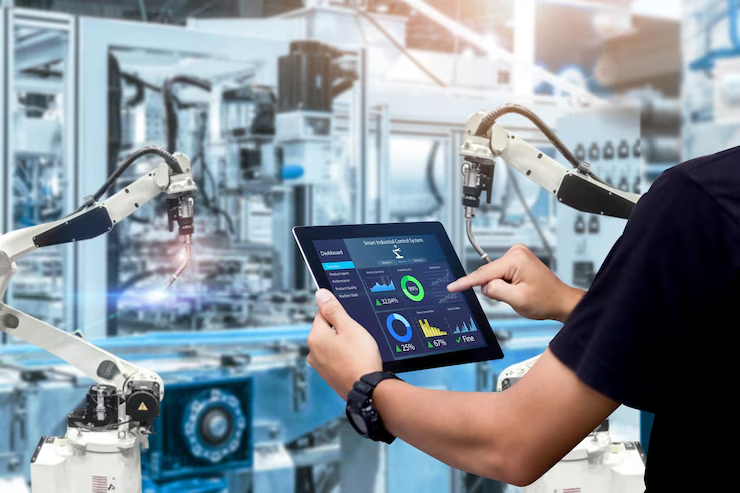Robotic Process Automation (RPA): The Future of Business Efficiency

In today’s fast-paced digital world, organizations are constantly seeking ways to improve efficiency, reduce costs, and enhance customer experience. One of the most powerful technologies enabling this transformation is Robotic Process Automation (RPA). As businesses are overwhelmed with repetitive, rule-based tasks that drain human potential, RPA emerges as a practical solution. It automates these tasks, allowing employees to focus on higher-value activities.
This article provides a deep dive into RPA: what it is, how it works, examples of its application, its relationship with Artificial Intelligence (AI), the best tools in the market, coding requirements, and its career prospects.
What is Robotic Process Automation (RPA)?

Robotic Process Automation (RPA) refers to the use of software robots—or “bots”—to automate repetitive, rule-based digital tasks. These tasks can include anything from data entry, invoice processing, generating reports, handling customer queries, to processing transactions. The bots mimic human interactions with software systems and applications to perform tasks with high accuracy and efficiency.
Key Features of RPA:
-
Non-intrusive: It works on top of existing IT infrastructure without disrupting underlying systems.
-
Rule-based: It automates tasks that follow structured, logical steps.
-
High-volume: It is designed for processes that occur frequently and at scale.
-
Digital workforce: Bots act as a virtual workforce that operates 24/7 without breaks.
RPA Example: Invoice Processing

To understand RPA in action, consider the invoice processing system in an organization.
Manual Process:
-
An employee opens emails with invoices.
-
Saves the invoice to a shared drive.
-
Extracts relevant information (like invoice number, vendor name, amount).
-
Logs into an ERP system and inputs the data.
-
Confirms and closes the transaction.
Automated with RPA:
-
A bot scans incoming emails.
-
Downloads and saves invoices.
-
Uses Optical Character Recognition (OCR) to extract relevant data.
-
Logs into the ERP system.
-
Inputs data, verifies against business rules, and submits it.
-
Sends confirmation or alerts in case of errors.
Result: The entire task, which might take a human 15–20 minutes, can be completed in seconds by the bot—accurately and consistently.
Is RPA a Form of AI?

RPA and AI are often mentioned together, but they are fundamentally different—although complementary.
Differences:
| Feature | RPA | AI |
|---|---|---|
| Definition | Automates rule-based, repetitive tasks | Simulates human intelligence to solve complex problems |
| Task Type | Structured and deterministic | Unstructured and probabilistic |
| Example | Data entry, form processing | Image recognition, language understanding |
| Learning | Doesn’t learn, follows explicit rules | Learns from data using algorithms |
Integration:
While RPA is not AI, the two can be integrated to create Intelligent Process Automation (IPA). For example:
-
AI analyzes unstructured email content.
-
RPA executes the structured workflow based on AI output.
Thus, AI provides cognitive capabilities (like decision–making and prediction), while RPA provides task execution.
Which RPA Tool is Best?

The RPA market is competitive and rapidly evolving. The choice of tool depends on the organization’s needs, budget, existing infrastructure, and technical capabilities.
Top RPA Tools in 2025:
-
UiPath:
-
Most popular RPA platform.
-
Offers a wide range of features, including AI integration, attended/unattended automation, and strong community support.
-
User-friendly with a drag-and-drop interface.
-
Ideal for enterprises and small businesses alike.
-
-
Automation Anywhere:
-
Known for its cloud-native platform.
-
Offers both bots and AI-powered insights.
-
Strong enterprise-level capabilities and real-time analytics.
-
-
Blue Prism:
-
One of the pioneers of RPA.
-
Best for large-scale, enterprise-level automation.
-
More focused on IT-led automation, with robust governance and security.
-
-
Microsoft Power Automate:
-
A cost-effective tool with strong integration into Microsoft 365.
-
Great for businesses using the Microsoft ecosystem.
-
Simple workflows and automation for non-technical users.
-
-
Kofax RPA:
-
Focuses on document-intensive processes.
-
Offers intelligent automation features with strong OCR capabilities.
-
Choosing the Best Tool:
Factors to consider:
-
Ease of use
-
Scalability
-
Integration capabilities
-
AI/ML support
-
Community and support
-
Licensing cost
Does RPA Require Coding?
This is a common question for individuals and organizations planning to adopt or learn RPA.
The short answer: Not necessarily.
Modern RPA tools are designed with low-code or no-code platforms, meaning that users can build bots using visual workflows, drag-and-drop interfaces, and predefined templates.
When Coding May Be Needed:

-
Custom Integrations: If a system isn’t natively supported by the RPA tool.
-
Complex Logic: Advanced bots may require conditional logic, loops, and exception handling.
-
Data Manipulation: Handling APIs, transforming datasets, or integrating with databases.
Supported Languages:
-
UiPath: VB.NET, C#
-
Automation Anywhere: Custom scripts in Python, JavaScript
-
Blue Prism: VB.NET
-
Microsoft Power Automate: Logic Apps, PowerShell
For most business use cases, basic bot creation doesn’t require extensive programming knowledge. However, developers or tech-savvy users can unlock more capabilities through scripting.
Is RPA Easy to Learn?
Yes, RPA is generally considered easy to learn, especially for people with a background in business processes, operations, or IT. The ease of learning depends on:
-
The complexity of the tasks being automated.
-
The tool being used.
-
The learner’s background (business analyst vs. software developer).
Learning Curve:
-
Beginner: Can start with visual workflows and templates. Tools like UiPath Academy and Automation Anywhere University offer free resources and certifications.
-
Intermediate: Learn about selectors, error handling, and basic scripting.
-
Advanced: Use custom coding, AI integration, and large-scale deployment.
Resources:
-
Free platforms like UiPath Academy, LinkedIn Learning, Coursera, and YouTube provide step-by-step tutorials.
-
Community forums and GitHub offer real-world use cases and code samples.
What Language is Used in RPA?
While many RPA tools provide no-code platforms, there are still underlying scripting languages and integration options.
Common Languages:
| Tool | Languages |
|---|---|
| UiPath | VB.NET, C#, Python (via integration) |
| Automation Anywhere | JavaScript, Python |
| Blue Prism | C#, VB.NET |
| Power Automate | PowerShell, Expressions |
| Kofax | JavaScript, XML |
The scripting languages are used to enhance bots, handle exceptions, manipulate data, and integrate with third-party tools or APIs.
For custom development, especially in backend integration or data handling, knowledge of Python or JavaScript is highly valuable.
Is RPA a Good Career?
Absolutely. RPA is one of the fastest-growing areas in IT and business process management.
Reasons RPA is a Great Career Choice:
-
High Demand:
-
Organizations across industries are adopting RPA to reduce operational costs and improve efficiency.
-
Demand is growing for roles such as RPA Developers, Analysts, Architects, and Project Managers.
-
-
Good Salaries:
-
RPA professionals earn competitive salaries, often above traditional IT roles due to their specialized skills.
-
-
Diverse Roles:
-
Business Analyst
-
RPA Developer
-
RPA Solution Architect
-
Process Consultant
-
RPA Project Manager
-
-
Future-Proof:
-
RPA is evolving into Intelligent Automation, combining with AI, ML, and analytics, offering long-term career opportunities.
-
-
Global Adoption:
-
Multinational corporations, SMEs, and even public sector organizations are adopting RPA worldwide.
-
Can I Use Python for RPA?
Yes, Python is one of the most popular programming languages for building custom RPA bots and integrating with AI models. While tools like UiPath and Automation Anywhere have their built-in workflows, they allow for scripting with Python to extend functionality.
Python in RPA:
-
Data manipulation using libraries like Pandas.
-
Web scraping with BeautifulSoup or Selenium.
-
APIs for third-party integrations.
-
Machine learning with scikit-learn or TensorFlow.
-
Custom logic where built-in activities are insufficient.
Also, there are Python-based RPA frameworks such as:
-
TagUI: Open-source, easy to learn.
-
RPA for Python (rpa.py): A simplified library for automating tasks.
-
Robot Framework: A test automation framework that can be used for RPA.
What is the Main Language Used in Robotics?
In robotics, especially in the hardware and embedded systems domain (distinct from RPA), the most commonly used languages are:
-
C/C++: For real-time performance and control of hardware.
-
Python: Widely used for AI, machine learning, and prototyping.
-
ROS (Robot Operating System): Uses a combination of C++ and Python.
-
MATLAB: Used in research and development for simulation and modeling.
RPA, although part of “robotic” automation, is primarily software-based, while robotics deal
RPA is a versatile technology with applications across industries. Its core appeal lies in automating high-volume, repetitive, and rule-based tasks.
Industries and Use Cases:
-
Banking and Finance:
-
Loan processing
-
Account opening
-
Fraud detection
-
Compliance reporting
-
-
Healthcare:
-
Claims processing
-
Patient data management
-
Appointment scheduling
-
-
Retail and E-commerce:
-
Inventory management
-
Customer service automation
-
Invoice generation
-
-
Insurance:
-
Policy issuance
-
Underwriting
-
Claims adjudication
-
-
Telecommunications:
-
Customer onboarding
-
Billing
-
Network management
-
-
Manufacturing:
-
ERP integration
-
Order processing
-
Supply chain automation
-
-
Human Resources (HR):
-
Resume screening
-
Employee onboarding
-
Payroll automation
-
What Language is Used in AI Robotics?
AI robotics refers to robots that leverage artificial intelligence to make decisions, adapt to environments, and learn from data.
Languages used in AI Robotics:
-
C++: Used for performance-critical applications in robotics.
-
Java: Used in some AI platforms and for Android-based robots.
These languages help integrate sensing (vision, touch), decision-making, and actuation in AI-enabled robots.
How is RPA Programmed?
RPA programming involves:
-
Designing workflows using drag-and-drop tools.
-
Configuring triggers and inputs to start the process.
-
Defining logic and rules the bot must follow.
-
Adding exception handling for error cases.
-
Deploying and monitoring the bot using an orchestrator.
Programming Tools:
-
UiPath Studio: Drag-and-drop + VB.NET + C#
-
Automation Anywhere Control Room: Recorder, logic builder, script editor
-
Blue Prism Studio: Visual process design with scripting support
Conclusion
By automating mundane and repetitive tasks, Robotic Process Automation (RPA) to enhance productivity, reduce costs, and improve accuracy.
With the right tools, skills, and mindset, you can tap into a world of opportunities offered by automation—and perhaps even be part of the revolution that’s defining the future of work.



Điểm nổi bật của xn88 com không chỉ nằm ở giao diện thân thiện, tốc độ xử lý mượt mà trên cả điện thoại và máy tính, mà còn ở công nghệ bảo mật tiên tiến, giúp người dùng yên tâm sử dụng dịch vụ mọi lúc mọi nơi. Đặc biệt, deegarciaradio.com hoạt động hợp pháp dưới sự cấp phép của tổ chức PAGCOR – Philippines, đảm bảo yếu tố minh bạch và ổn định trong quá trình vận hành.
live slot365 Mỗi tựa game giải trí tại danh mục đều do nhà phát hành đình đám hàng đầu thế giới liên kết với sân chơi đem đến. Điều này giúp đảm bảo mọi trò chơi đều thiết kế, cập nhật tính năng mới mẻ mỗi ngày giúp đáp ứng tất cả nhu cầu săn thưởng của anh em. Ngoài việc có cơ hội trải nghiệm tính năng mới mẻ thì anh em còn được khám phá tỷ lệ trả thưởng siêu cao cùng với quy trình thanh toán minh bạch, rõ ràng và an toàn tuyệt đối.
Nhờ giao diện hiện đại, bảo mật cao, cùng chiến lược toàn cầu hóa thông minh, 888slot game không chỉ nổi bật mà còn trở thành biểu tượng mới của sự đẳng cấp và an toàn trong ngành cá cược trực tuyến. TONY12-15